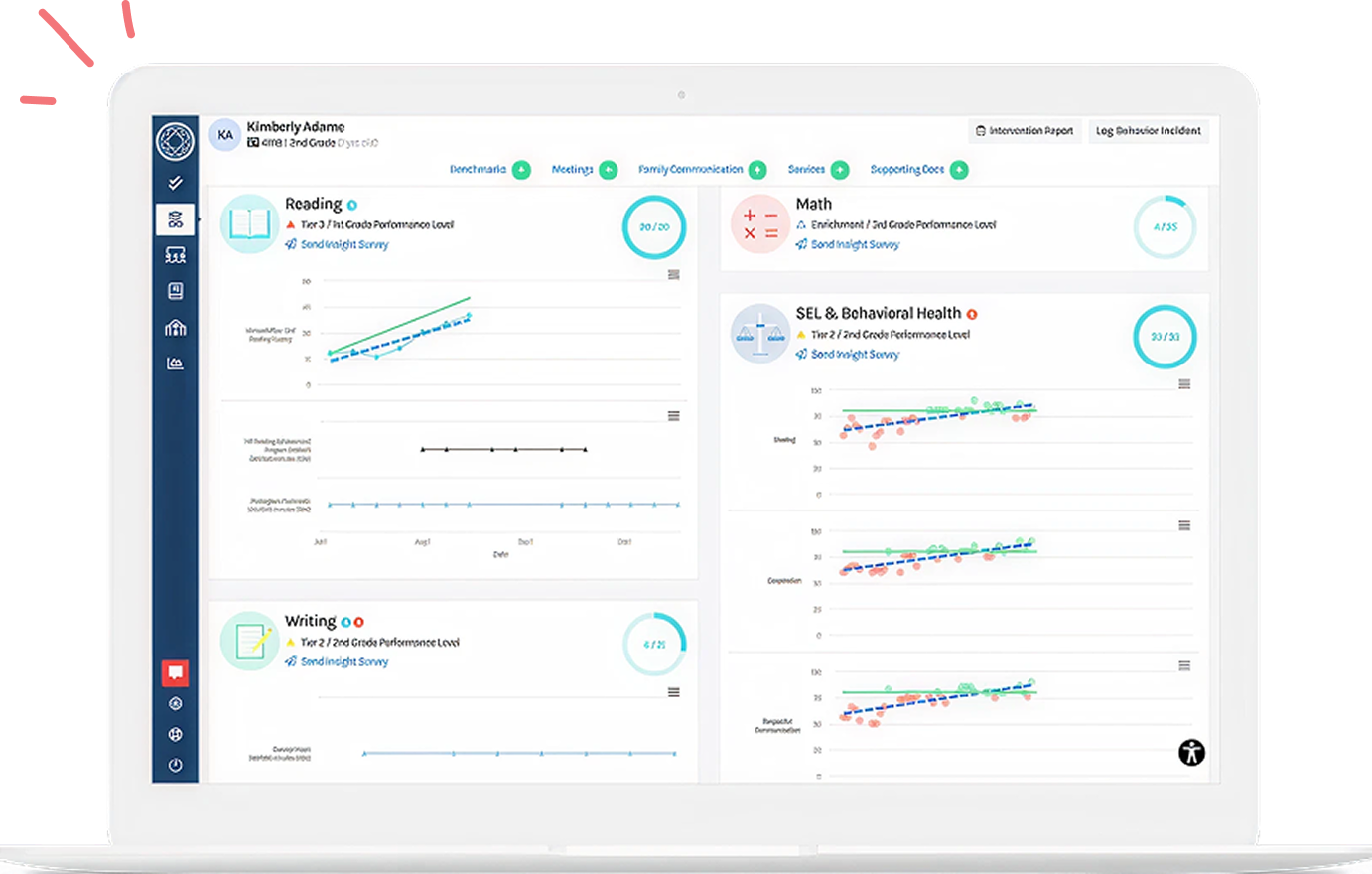Whenever I mention I taught middle school, the reactions are predictable: either a wide-eyed “Wow, you’re so brave!” or a grim “Middle school? That was the worst time of my life.” While it’s true that these years can be challenging for many students, I discovered something special during my time as a teacher. There’s a unique joy in witnessing who middle school students are becoming—caught between the fun of childhood and the journey into young adulthood.
|
MTSS in Middle School Highlights |
|
Middle school is a pivotal time of emotional, physical, and academic growth, marked by big transitions and rising expectations. A Multi-Tiered System of Supports (MTSS) is a powerful framework to help all students succeed, but it comes with unique challenges. Overcoming logistical hurdles and fostering collaboration are key to making MTSS effective.
Keep reading for practical strategies that address common obstacles for MTSS in middle school.
 Why is MTSS Vital for Middle Schools?
Why is MTSS Vital for Middle Schools?
MTSS serves as a critical support system during a pivotal stage in students’ education, ensuring each student is on track for success in high school and beyond.
What Makes Middle School MTSS Unique?
- Complex Student Needs: Middle schoolers balance academic demands, social-emotional development, and identity formation.
- Scheduling Limitations: Coordinating interventions across multiple subjects and periods requires careful planning.
- Specialized Teachers: Middle school educators often focus on specific subjects, which can make implementing school-wide intervention strategies more challenging.
 Four Key Strategies for Effective MTSS in Middle School
Four Key Strategies for Effective MTSS in Middle School
1. Foster a Collaborative Culture Among Educators
Collaboration is the backbone of MTSS success, but with 100+ students a day, having time to collaborate with my fellow teachers was a challenge. Research shows that when teams communicate effectively, they create a unified vision for MTSS, fostering both teacher buy-in and improved student outcomes. (Marlowe, 2021) Teachers, specialists, and administrators must work together to track student progress and share strategies.How to Build Collaboration in Middle School:
- Create a Building-level MTSS Team: Include content teachers, intervention specialists, administrators, school psychologists, and counselors. Assign roles like facilitator and note-taker to keep meetings focused and actionable.

- Use a Common Protocol: Adopt a problem-solving model—such as the MTSS problem solving model, problem identification, analysis, plan implementation, and evaluation.
- Schedule Regular Check-Ins: Teachers often have limited time, so designate part of team meetings, professional learning communities (PLCs) or staff meetings to review MTSS progress.
2. Use Data to Drive Decisions
Solid data practices enable schools to intervene earlier and with greater precision, preventing issues from escalating.
Steps to Implement Data-Driven Practices:
- Start with Universal Screening: Use high quality assessments to identify students who need additional support early. If screening all students is a challenge, track early warning indicatorslike attendance and grades.
- Track Progress Consistently: Keep detailed records of interventions through platforms or simple tracking documents.
- Analyze and Adjust: Regularly revisit data to refine interventions. For instance, middle schools that used collaborative teacher teams to evaluate progress monitoring data found more targeted success in Tier 2 interventions. (Durrance, 2023)
3. Adapt Scheduling to Support Interventions
Scheduling is one of the biggest hurdles in implementing MTSS at the middle school level. To make it work, schools need flexible yet structured schedules that prioritize intervention time. Restructured schedules allow teachers to meet for Tier discussions and reserve time for student interventions.
Solutions to Scheduling Challenges:
- Build Intervention Blocks: Designate a specific time in the school day for Tier 2 and Tier 3 interventions. For example, some schools create rotating advisory or flex periods. WIN (What I Need) time is one such strategy.
- Utilize Staff Creatively: Assign additional responsibilities to specialists or rotate teacher assignments within grade-level teams to cover intervention groups.
- Reduce Time Conflicts: Ensure intervention time doesn’t cause students to regularly miss core subjects.
➡️ Dig Deeper: Master Scheduling for MTSS
4. Invest in MTSS Professional Development
Middle school teachers are first and foremost content experts. They are focused on their classroom and department, and may not see the bigger picture. Few middle school teachers receive significant training in how MTSS works or specific intervention strategies. As a middle school English Language Arts teacher, I was an expert in teaching literature, not in foundational reading instruction. I needed training in how to support my students who struggled with basic reading and comprehension.
|
Teacher learning is critical for middle school MTSS success. |
Actions for Professional Development:
- Provide Dedicated MTSS Training: Offer workshops or on-demand resources that clarify roles in MTSS and build teacher confidence in implementing Focus on Core Instruction: Strengthen Tier 1 teaching with evidence-based practices, ensuring students receive high-quality teaching before layering in supports.
- Extend Coaching: Where feasible, assign instructional coaches or MTSS specialists to model strategies and provide feedback to teachers.
For instance, one middle school invested in targeted MTSS training for English Language Arts and math teachers, empowering them to integrate interventions directly into their subject classes. This reduced reliance on external intervention sessions. (Marlowe, 2021).
➡️ Dig Deeper: Master Coaching Toolkit
 Overcoming MTSS Roadblocks
Overcoming MTSS Roadblocks
Challenge 1: Overwhelmed Teachers
Many educators feel stretched too thin to take on additional intervention responsibilities. MTSS can feel like another “thing” on their already busy plates.
| For instance, during one of our PLC meetings, a principal stopped by and asked us to compile a list of students struggling with a particular skill and create a plan to support them. However, she didn’t specify which assessment to use, where to gather the data, or what resources to employ for interventions. This request to implement MTSS felt overwhelming and lacked clear direction. |
Solution: Investing time upfront in professional development, establishing protocols, and creating a comprehensive handbook can empower teachers with confidence throughout the year.
| Emphasize that MTSS isn’t “extra work” but rather a strategic framework designed to enhance existing efforts. |
By showcasing how MTSS streamlines processes and reduces workload, you can increase the likelihood of teachers embracing it wholeheartedly.
Challenge 2: Alignment Across Departments
Middle schools often struggle to align strategies across content areas or grade levels. Some middle schools may meet in departments, but not teams or teams and not departments. They may have one plan time (40-55 minutes a day) to do all their planning, grading and meeting.
Solution: Use frameworks like PLCs or MTSS team meetings to ensure everyone is on the same page. Connect those teams that may feel siloed, such as electives. Standardize processes (like data sharing), but leave room for subject-specific interventions. (American Institute for Research, 2021) Leave room for feedback throughout the process.
Challenge 3: Intervention Fatigue
Teachers and students may lose engagement if interventions feel repetitive or ineffective. Scheduling may create difficulties to help students move in and out of interventions as they progress or need more support.
| In one school I worked at, a student was enrolled in a reading class based on the previous years’ test scores, and even if they made progress, they would have to be in that class the whole semester. |
Solution: Regularly assess what’s working and adapt. Build in varied activities and motivate students by highlighting growth, not just grades. Make sure to have age appropriate resources, as well as ability levels.
 Building a Supportive and Collaborative Middle School Culture
Building a Supportive and Collaborative Middle School Culture
Schools that successfully adopted MTSS at the middle school level share some common themes. They consistently prioritize collaboration, data-driven decisions, flexible scheduling, and teacher training. These schools also foster cultures of growth, where students and educators believe success is within reach for everyone (Hollingsworth, 2019).
For example, one middle school used professional development sessions to train content-area teachers as interventionists. This proved particularly effective for Tier 2 supports, where small-group interventions during advisory periods led to noticeable gains in student achievement (Marlowe, 2021).
➡️ Dig Deeper: Mindset Is a Resource
 Making MTSS Work in Middle Schools
Making MTSS Work in Middle Schools
Teaching middle schoolers was a joy. Their tenacity, their aspirations, and yes, even their occasional sass, made every day an adventure (most of the time 😉). As one of many teachers in their journey, I saw my role as planting seeds of growth and fostering their potential during the time they spent in my classroom.
Middle school is a pivotal time – the right support can shape long-term success. MTSS ensures every student gets the help they need, despite the challenges of growing up in a fast-paced academic world. While implementing MTSS in middle schools can be challenging, success comes from fostering a supportive culture, prioritizing collaboration, and tailoring MTSS to fit middle school needs.
 Discover how Branching Minds can transform your approach to MTSS implementation Discover how Branching Minds can transform your approach to MTSS implementation |
|
With tailored tools, expert insights, and real-world strategies, Branching Minds empowers educators to better support every student. |
References:
American Institute for Research. (2021). Considerations for MTSS implementation in middle school settings. https://mtss4success.org/. https://mtss4success.org/sites/default/files/2021-06/Considerations_for_MTSS_Implementation_Middle_School_Settings.docx
Durrance, S. (2023). Implementing MTSS in Secondary Schools: Challenges and Strategies. Comprehensive Center Network. https://region6cc.uncg.edu/wp-content/uploads/2022/06/ImplementingMTSSinSecondarySchools_2022_RC6_003.pdf
Hollingsworth, S. M. (2019). Multi-tiered System of Supports as Collective Work: a (Re)structuring Option for Middle Schools. Current Issues in Middle Level Education, 24(2), 4. https://doi.org/10.20429/cimle.2019.240204
Marlowe, A. (2021). Multi-Tiered System of Supports: A Case Study Examining Effective MTSS Implementation at the Middle School Level. Digital Commons @ Gardner-Webb University. Retrieved January 30, 2025, from https://digitalcommons.gardner-webb.edu/education-dissertations/36/
Napolitan, L. (2022, August 30). How to empower secondary teachers through MTSS. Branching Minds. Retrieved from https://www.branchingminds.com/blog/empower-secondary-teachers-mtss

About the author
Larissa Napolitan
Larissa Napolitan is the Content Marketing Manager at Branching Minds and host of the Schoolin’ Around podcast, where she spotlights innovative voices and practices shaping education today. A former middle school teacher and instructional coach, Larissa draws on her classroom experience to create meaningful content that connects research, storytelling, and practical insights for school and district leaders. She is passionate about amplifying educator voices and supporting the growth of all students.

Your MTSS Transformation Starts Here
Enhance your MTSS process. Book a Branching Minds demo today.


















.png?width=716&height=522&name=The%20Power%20of%20Good%20Data%20(blog).png)